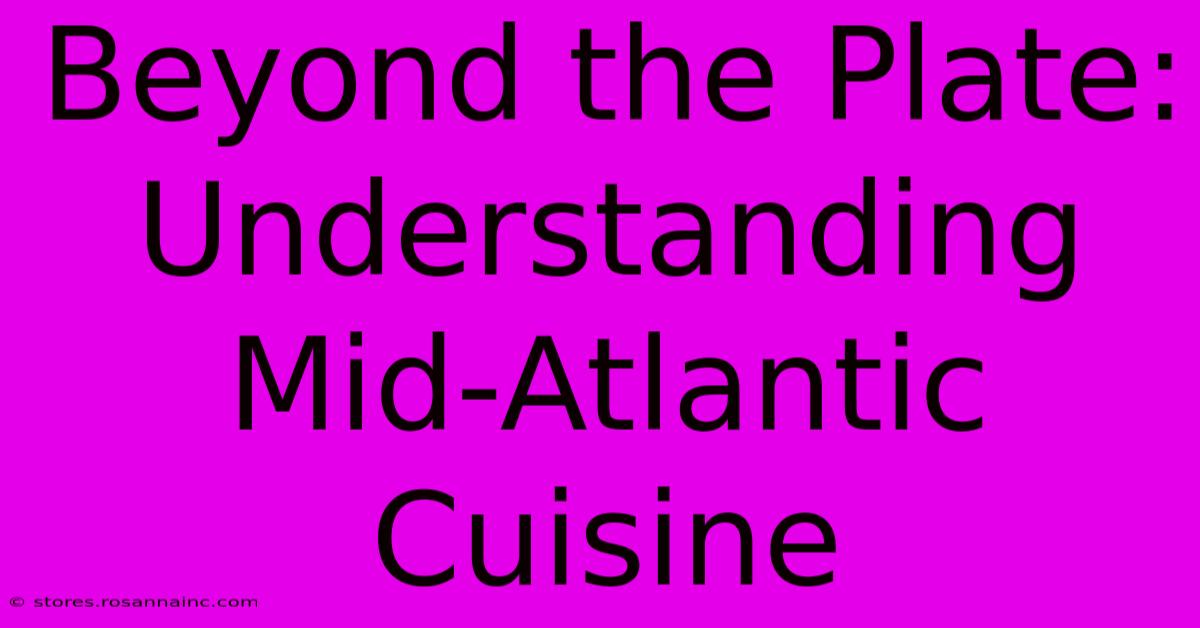Beyond The Plate: Understanding Mid-Atlantic Cuisine

Table of Contents
Beyond the Plate: Understanding Mid-Atlantic Cuisine
The Mid-Atlantic region, a culinary melting pot stretching from New York to Virginia, boasts a rich and diverse gastronomic landscape often overlooked in favor of its more celebrated neighbors. This article delves beyond the typical crab cakes (though we'll touch on those!) to explore the unique influences and evolving flavors that define Mid-Atlantic cuisine.
A History Served on a Plate: Influences and Evolution
Understanding Mid-Atlantic cuisine requires acknowledging its layered history. Unlike regions with singular, dominant culinary traditions, this area reflects centuries of immigration and trade.
Native American Roots:
Long before European colonization, Indigenous peoples shaped the region's culinary identity. Their knowledge of foraging, farming, and utilizing local ingredients – like wild berries, nuts, and various game – formed a foundational layer. While less overtly present in modern Mid-Atlantic fare, the legacy of resourcefulness and seasonal eating remains.
European Impacts:
The arrival of European settlers dramatically altered the culinary landscape. Dutch, English, German, and other European influences blended, creating a unique hybrid. Think hearty stews, pickled vegetables, and the introduction of livestock farming – all contributing to the robust dishes characteristic of the region.
The Chesapeake Bay's Bounty:
The Chesapeake Bay, a vital waterway, significantly shaped the region’s culinary identity. Seafood, particularly blue crabs, oysters, and rockfish, became staples, leading to the development of iconic dishes like crab cakes, steamed clams, and oyster roasts. The unique ecosystem of the Bay fostered distinct culinary traditions centered around sustainable practices and the abundance of fresh seafood.
The Rise of Modern Mid-Atlantic Cuisine:
Today, Mid-Atlantic cuisine continues to evolve, incorporating global influences and embracing farm-to-table philosophies. Chefs are increasingly focusing on sustainable practices, highlighting local ingredients, and experimenting with innovative techniques while staying true to the region's historical culinary roots.
Iconic Dishes and Regional Variations:
While generalizations are risky, certain dishes represent the core of Mid-Atlantic culinary heritage:
Crab Cakes:
Perhaps the most famous representative, crab cakes are far from monolithic. Maryland crab cakes, for example, often emphasize lump crab meat and minimal filler, while variations across the region might incorporate breadcrumbs, spices, and even vegetables. The quality of the crab meat is paramount, and discerning diners can readily identify variations based on the crab's origin and preparation.
Oysters:
From steamed to fried, raw to roasted, oysters are another essential ingredient. The Chesapeake Bay, renowned for its oysters, provides numerous varieties, each with its unique flavor profile. Oyster roasts are a quintessential social event, offering a chance to savor these delicacies in a lively, communal setting.
Smithfield Ham:
Virginia's Smithfield ham, a dry-cured ham known for its distinctive smoky flavor, represents the region's commitment to cured meats. Its rich history and unique production process contribute to its highly prized status.
Pennsylvania Dutch Cuisine:
Moving inland, Pennsylvania Dutch cuisine adds another layer of complexity. Hearty dishes like scrapple, pot pie, and shoofly pie reflect the enduring influence of German settlers. These often feature unique baking and preservation techniques passed down through generations.
Beyond the Classics: Exploring Modern Trends
Today’s Mid-Atlantic culinary scene is vibrant and innovative. Many chefs are focusing on:
- Sustainable seafood sourcing: Consciously choosing sustainably harvested seafood is crucial in preserving the region's rich aquatic resources.
- Local and seasonal ingredients: Farmers' markets and local farms are increasingly utilized, ensuring freshness and supporting regional agriculture.
- Fusion cuisine: Blending traditional Mid-Atlantic flavors with techniques and ingredients from other culinary traditions creates exciting new dishes.
Conclusion: A Culinary Journey Awaits
The Mid-Atlantic region offers a compelling culinary journey for both the seasoned gourmand and the curious newcomer. By understanding its layered history, diverse influences, and evolving trends, we can truly appreciate the unique character of its cuisine – a delicious blend of tradition and innovation. So, the next time you're exploring this part of the United States, be sure to venture beyond the familiar and discover the unexpected flavors waiting to be savored.

Thank you for visiting our website wich cover about Beyond The Plate: Understanding Mid-Atlantic Cuisine. We hope the information provided has been useful to you. Feel free to contact us if you have any questions or need further assistance. See you next time and dont miss to bookmark.
Featured Posts
-
Impress Your Friends Georgias Capital Revealed
Feb 10, 2025
-
Te Sientes Seguro Descubre La Realidad Policial De Centroamerica
Feb 10, 2025
-
See Rubi Rose Like Never Before
Feb 10, 2025
-
Experience Exceptional Care Mds In Annapolis Junction
Feb 10, 2025
-
Beyond The Box Score Cubs Vs Guardians Player Stats Revealed
Feb 10, 2025
